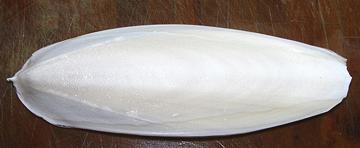
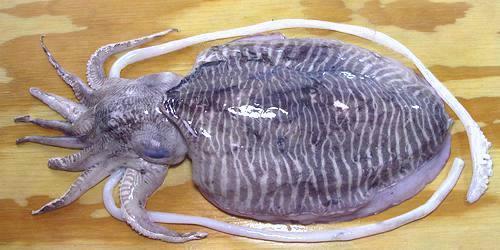 [Sepia pharaonis (and others)]
[Sepia pharaonis (and others)]
This "cleaning and dismantling" page features a Pharaoh Cuttlefish, as that is the only large cuttlefish available in the Indo-Pacific region. While no Cuttlefish are native to either coast of the Americas, this one is shipped to California from Vietnam, so available in the large Asian markets here in Los Angeles. The same instructions should work for the Common Cuttlefish, found off the east coasts of Europe and Africa, as well as the Mediterranean.
More on Cuttlefish.
Cooking Cuttlefish.

There is relatively little cutting to dismantling a cuttlefish. Most of it is just pulled apart by hand, but the first thing you do is make ad cut through the skin at the front of the mantle just above the cuttlebone and another just below it. The Cuttlebone can then be pushed and pulled out through the cut.
Cuttlebone Removed

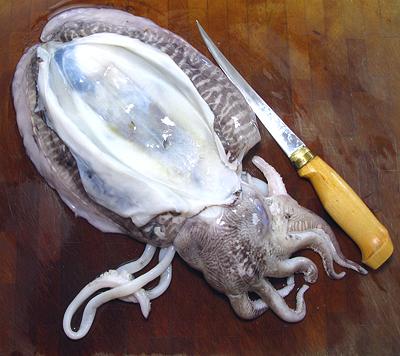
Now you want to make a single cut through the skin at the top of
the Cuttlefish. Hold the skin up so you don't cut into the stuff that's
below it. Then, get your fingers in between the fin meat and the
inside meat and pull outward to expose the sack of innards inside.
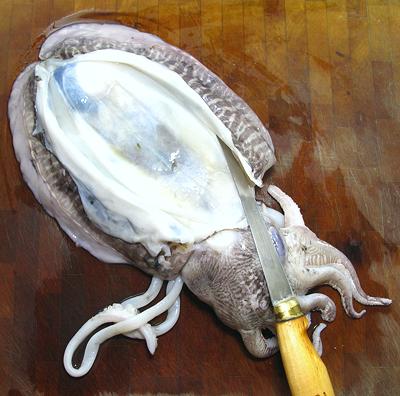
You need to make a short cut up at the front on each side and
a shorter cut at the back where the fins meet to free them so you
can open the Cuttlefish wider.
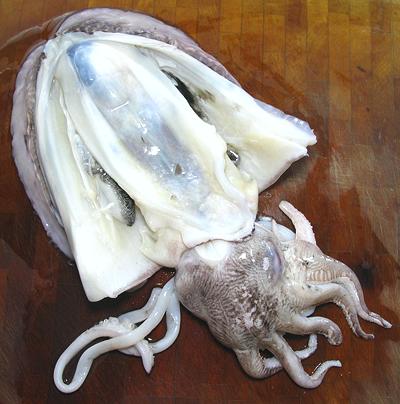
Just pull the fin sides out to open the Cuttlefish wide.
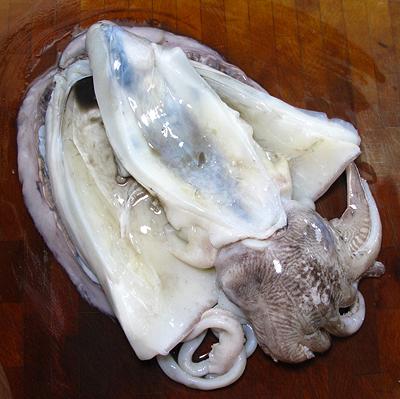
Now get your fingers in under the sack of innards and pull it loose
at the aft end. Now pull off the Head along with the sack of innards
and set the body aside.
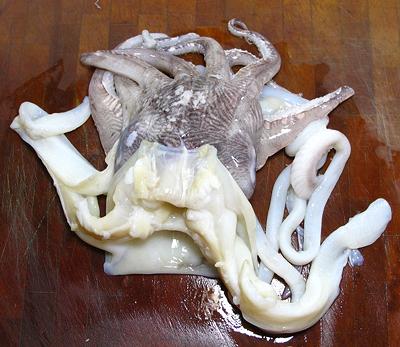
Pull or cut loose any membranes so you have the head separated from the sack of innards, which can be discarded. Clean up the head well under running water. In a separate compartment there will be the liver, which is brown. It may still be in its two pouches or may be just a bunch of brown stuff. Clean that all so your head looks as in the photo.
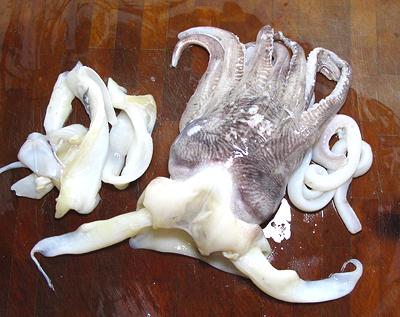
Continue to remove loose membranes and cut off the two long meaty
parts. Do not discard them.
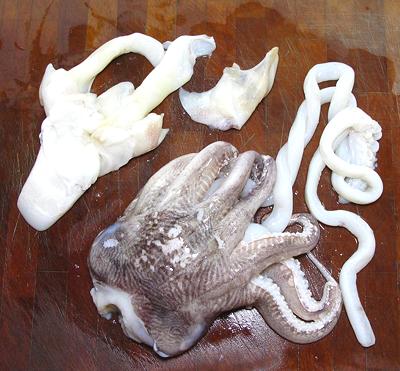
Right at the back of the head you will feel some stiff parts. Cut
them loose and discard (they're shown top center in the photo. Remove
the rest of the meaty parts and do not discard them.
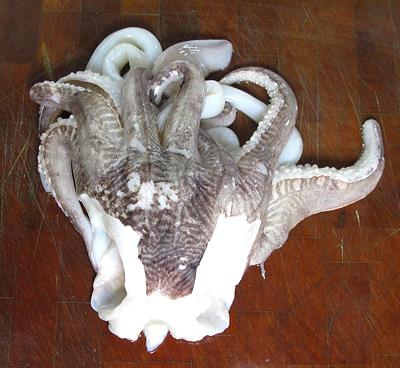
Cut around the eyes and remove them. if you cut too close and they
deflate, that's not a problem - you're tossing them out. Just rinse
the head to clean up.
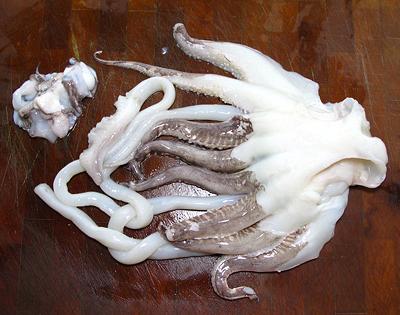
Get a grip on the skin at the back of the head, first at the
bottom and pull slowly toward the arms. It will break loose from
the arms where it gets thin. Now, do the same with the skin at
the top of the head. The skin left on the arms is too thin to
be a bother.

The eye sockets are very stiff, so remove them. This will also
expose the inside of the mouth. So you can push out the beak and
cut it off.
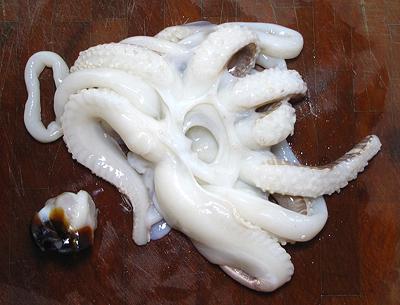
Stick a finger in the hole at the back of the arms and
push the beak out the front where you can cut it off.
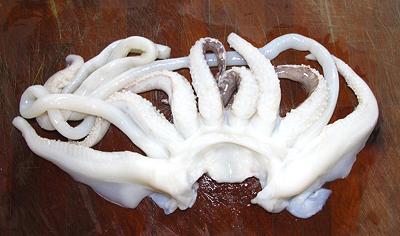
Make a cut through the arm ring between the largest arms
so you can spread them out. Now cut each arm free from its neighbors.
At this point, if there is too much of the colored skin on one or more
arms, you can shave it off with your filleting knife. You'll
probably want to cut those two long tentacles into about the same
lengths as the arms.
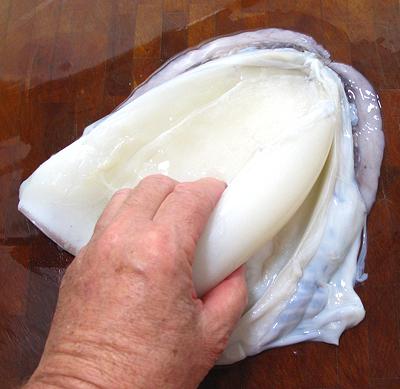
Use your fingers to pull the body meat loose from the fins and belly
skin.

Remove any clinging membranes and other stuff. It may help to
scrub it on both sides with coarse seas salt as an abrasive. Don't
discard the stuff over on the right - there's still meat to be
recovered there.
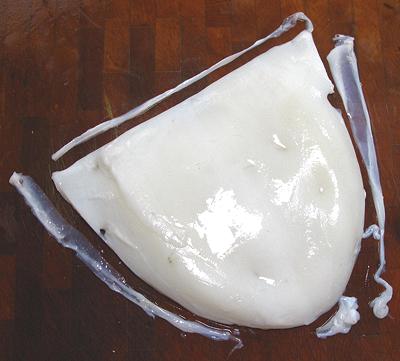
Make a thin cut across the straight edge and cut off the stiff
fin along the curved edges.

Pull the strips of white meat off the fin skins and belly. You
will find a thin translucent fin cartilage attached to each of the
strips. Use your filleting knife to shave it off the meat. Discard
cartilage and skins.